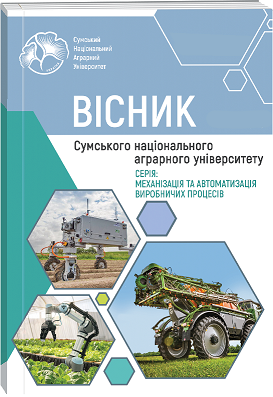CHANGE OF THE VALUE OF SOIL RESISTANCE WHEN PERFORMING AGRICULTURAL WORKS IN CROP GROWING
Abstract
This article is devoted to the study of factors affecting the change in the specific resistance of the machine unit during mechanized technological operations in agriculture. As a result of the analysis and on the basis of a computational experiment, it was determined that the bluntness of the blade of the working bodies, the type and characteristics of the soil, as well as the speed and operating conditions of the machine units are the factors that have the greatest impact on the resistance of the soil to the working bodies and on the quality of cultivation and sowing and productivity. In particular, the blunting of the blade and the formation of a reverse chamfer negatively affects the quality of sowing and the yield of grain crops due to the over-compaction of the bottom of the furrow, which prevents the supply of capillary moisture to the seeds and the penetration of plant roots into the lower layers of the soil. The study showed that the wear of working bodies and the specific resistance of the machine unit are interdependent. Increased resistance leads to a decrease in work efficiency, excess fuel consumption, accelerated wear of the surface of the working organs and a decrease in productivity. The conducted studies showed a significant influence of speed on the technical and operational indicators of the operation of the machine unit, in particular on work productivity, fuel consumption and the cost of cultivating a hectare of field. Graphical models demonstrate the growth of work productivity with an increase in work speed, as well as a greater intensity of change in work productivity when using machine units with a larger number of cases. In addition, they reflect the influence of the speed of operation on the fuel consumption of machine units. Fuel consumption during the operation of machine units with a normal load should be lower, the smaller the number of housings available in the agricultural machine, which is attached to it, under the condition of the identity of other output data and the same speed of operation. As the experiments showed, this trend was not fully seen, the machine unit consisting of John Deere 6095 B + EurOpal 5, which had the smallest number of cases among the compared options, had increased fuel consumption, which indicates its operation with overload. Graphical models also demonstrated the influence of speed on the cost of field work. With an increase in speed in the range from 5 to 12 km/h and the number of bodies in the design of the agricultural machine, less and less money is needed to cultivate one hectare of field. In addition, with each subsequent increase in the number of housings in the design of the agricultural machine by one, the difference in cost compared to the previous version was less and less.
References
2. Bernshtein D.B. (2012). Abrazyvne znoshuvannia lemishnoho leza ta pratsezdatnist pluha. Traktory ta silhospmashyny. [Abrasive wear of the plow blade and plow performance. Tractors and agricultural machines]. – № 6. – S. 40-45 (in Ukrainian).
3. Bieliaiev, V.I., Kryvochurov, N.T., Shaikhudinov, A.S., Ivanaiskyi, V.V. Vplyv parametriv znosu robochykh orhaniv siialkykultyvatora na yakist sivuvannia i vrozhainist yarovoi pshenytsi. [The influence of wear parameters of the working organs of the seeder-cultivator on the quality of sowing and the yield of spring wheat.]. Visnyk Altaiskoho derzhavnoho ahrarnoho universytetu. – 2009. – № 7. – S. 50-53. (in Ukrainian)
4. Demin, D. (2023). Experimental and industrial method of synthesis of optimal control of the temperature region of cupola melting. EUREKA: Physics and Engineering, 2, 68–82. doi:10.21303/2461-4262.2023.002804
5. Dotsenko, Y., Dotsenko, N., Tkachyna, Y., Fedorenko, V., Tsybulskyi, Y. (2018). Operation optimization of holding furnaces in special casting shops. Technology Audit and Production Reserves, 6 (1 (44)), 18–22. doi:10.15587/2312-8372.2018.150585
6. Frolova, L., Shevchenko, R., Shpyh, A., Khoroshailo, V., Antonenko, Y. (2021). Vybir optymalnykh poiednan Al–Si v chavuni dlia vylyvkiv mashynobudivnoho pryznachennia. [Selection of optimal Al–Si combinations in cast iron for castings for engineering purposes]. EVRYKA: Fizyka ta inzhyneriia, 2, 99–107. (in Ukrainian) doi:10.21303/2461-4262.2021.001694
7. Hoormazdi G., Küpferle J., Röttger A., Theisen W., Hack K. A (2019).Concept for the Estimation of Soil Tool Abrasive Wear Using ASTM G65 Test Data. International Journal of Civil Engineering. No 17. Р. 103-111. doi:10.1007/s40999-018-0333-9
8. Lysenkov, V., Demin, D. (2022). Reserves of resource saving in the manufacture of brake drums of cargo vehicles. ScienceRise, 3, 14–23. doi:10.21303/2313-8416.2022.002551
9. Makarenko, D. (2017). Doslidzhennia poverkhon vidhuku, shcho opysuiut matematychnu model vplyvu temperatury ta vmistu BeO v kompozytsiinykh materialakh na tekuchist i mezhu mitsnosti. [Investigation of the response surfaces describing the mathematical model of the influence of temperature and BeO content in the composite materials on the yield and ultimate strength]. Tekhnolohichnyi audyt i rezervy vyrobnytstva, 3 (3 (35)), 13–17. (in Ukrainian) doi:10.15587/2312-8372.2017.104895
10. Mikulina, M., & Polyvanyi, A. (2023). Funktsionuvannia systemy tekhnichnoho servisu v APK. [Functioning of the technical service system in the agricultural industry.]. Aktualni pytannia u suchasnii nautsi, (3 (9)). (in Ukrainian) doi:10.52058/2786-6300-2023-3(9)-97-106
11. Pohorilyi V. (2015) Doslidzhennia efektyvnosti riznykh typiv dyskovykh robochykh orhaniv pry poverkhnevomu obrobitku hruntu Veles-Ahro. [Study of the effectiveness of different types of disc working bodies in the surface cultivation of Veles-Agro soil]. (in Ukrainian) URL: http://www.velesagro.com/company/arti cles/2015/07/21/19/
12. Rogovskii I. L., Borak, K. V., Maksimovich E. Yu., Smelik V. A., Voinash, S. A., Maksimovich, K.Yu., Sokolova, V.A. (2020) Znosostiikist lezovykh i dyskovykh robochykh orhaniv gruntoobrobnykh mashyn, hartovanykh elektrodamy T-serii. [Wear resistance of blade and disc working bodies of tillage tilling machines hardened by electrodes T-series]. Zhurnal fizyky: Seriia konferentsii. 1679 (4), st. № 042084. (in Ukrainian)
13. Zubko, V. M., Melnyk, V. I., Sokolik, S. P., Shpatak, R. I., Zubko, V. N., Melnyk, V. Y., … & Shpatak, R. Y. (2018). Doslidzhennia yakisnykh pokaznykiv roboty dyskovoi borony. [Study of quality indicators of disk harrow operation.]. (in Ukrainian) doi:10.31548/dopovidi2018.06.029
14. Zubko, V., Roubík, H., Zamora, O., & Khvorost, T. (2018). Analiz ta prohnoz ekspluatatsiinykh kharakterystyk zernozbyralnykh kombainiv. [Analysis and forecast of performance characteristics of combine harvesters]. (in Ukrainian) doi:10.15159/AR.18.212
15. Zubko,V.,Sirenko,V.,Kuzina,T.,Onychko,V.,Sokolik,S.,Roubik,H.,Koszel,M. & Shchur,T.(2022). Modeliuvannia rukhu zerna pshenytsi pid chas sivby na osnovi modeli zerna zi zmishchenym tsentrom vahy. [Modelling Wheat Grain Flow During Sowing Based on the Model of Grain with Shifted Center of Gravity]. Silskohospodarske mashynobuduvannia, 26(1) 25-37. (in Ukrainian) doi:10.2478/agriceng-2022-0003

 ISSN
ISSN  ISSN
ISSN 



